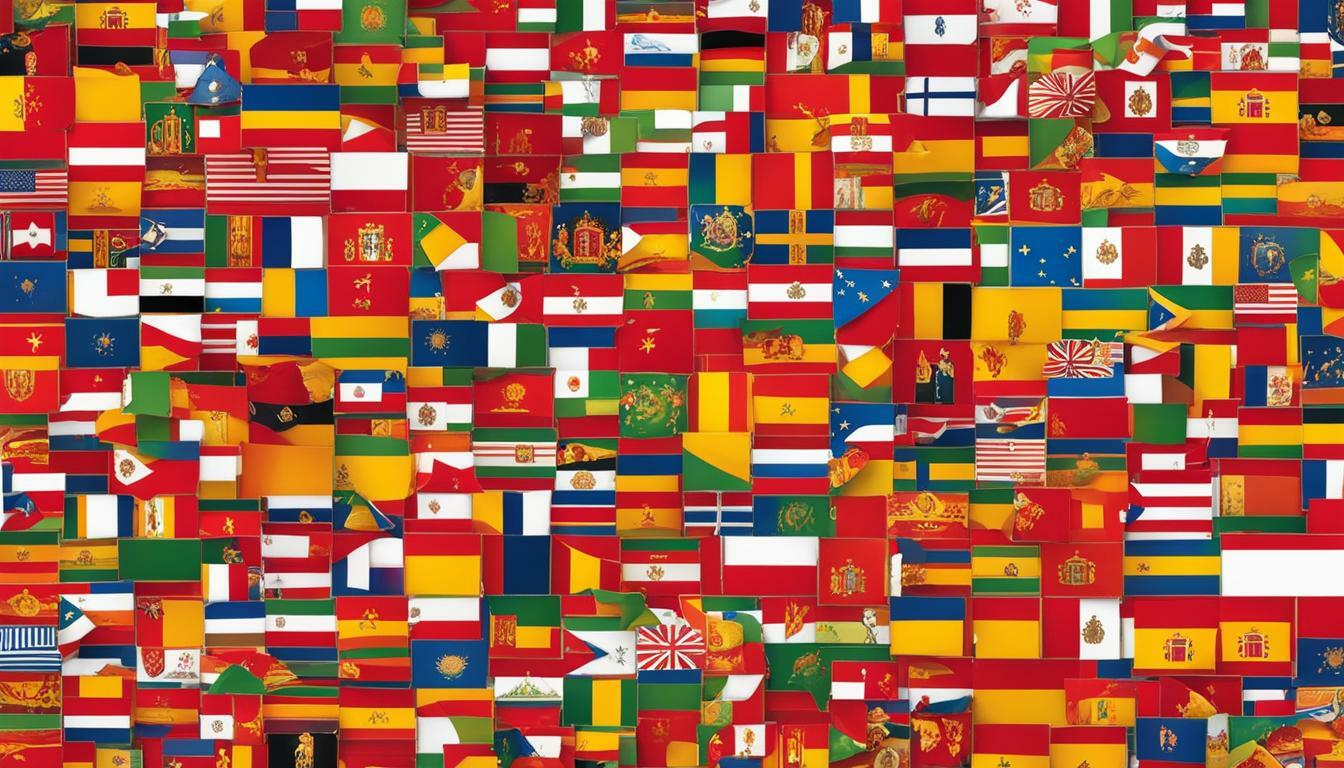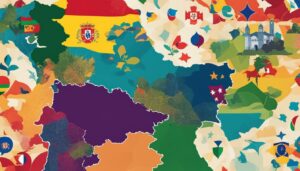Spain is a culturally diverse nation with multiple languages spoken throughout the country. The official language of Spain is Spanish, also known as Castilian. However, there are several co-official languages spoken in different regions of the country.
Key Takeaways:
- Spanish, or Castilian, is the official language of Spain.
- Catalan/Valencian, Galician, Basque, and Aranese are co-official languages spoken in specific regions of Spain.
- Catalan is spoken in Catalonia, the Valencian Community, and the Balearic Islands.
- Galician is spoken in Galicia, Asturias, and Castile and León.
- Basque is spoken in the Basque Country and northern Navarre.
- Aranese is spoken in the Aran Valley.
- Other protected languages in Spain include Asturian, Aragonese, Fala, and various regional dialects.
Co-official Languages in Spain
In addition to Spanish, there are several co-official languages spoken in different regions of Spain, including Catalan, Valencian, Galician, Basque, and Aranese. These languages reflect the diverse linguistic heritage of the country and contribute to the cultural richness of each region.
Catalan and Valencian: Catalan is spoken in Catalonia, the Valencian Community, and the Balearic Islands. It shares many similarities with Valencian, which is spoken mainly in the Valencian Community. Both languages have their own standard literary forms and are widely used in education, media, and official communication in these regions.
Galician and Basque: Galician is spoken in Galicia, Asturias, and Castile and León. It has its roots in medieval Galician-Portuguese and is closely related to Portuguese. Basque, on the other hand, is a unique language isolate spoken in the Basque Country and northern Navarre. It is unrelated to any other known language and has a complex grammatical structure.
Aranese and Other Protected Languages: Aranese is spoken in the Aran Valley, a small valley in the Pyrenees. It is a variety of Gascon, a Romance language spoken in southwestern France. In addition to these co-official languages, Spain also recognizes other protected languages such as Asturian, Aragonese, and Fala, which is a Galician-Portuguese language. There are also various regional dialects that hold significance for the local communities.
| Language | Regions Spoken |
|---|---|
| Catalan | Catalonia, Valencian Community, Balearic Islands |
| Valencian | Valencian Community |
| Galician | Galicia, Asturias, Castile and León |
| Basque | Basque Country, Navarre |
| Aranese | Aran Valley |
While Spanish remains the most widely spoken language in Spain, it is important to recognize the linguistic diversity of the country. These co-official languages not only serve as a means of communication for their respective communities but also foster cultural identity and heritage. They are a testament to the rich tapestry of languages that exist within Spain, adding depth and variety to its linguistic landscape.
Catalan and Valencian
The Catalan language is spoken in Catalonia, the Valencian Community, and the Balearic Islands, and it is one of the co-official languages in these regions. With its roots in the Romance language family, Catalan has a rich history and distinctive features that set it apart from Spanish. Let’s take a closer look at this fascinating language and its cultural significance.
Key Features of Catalan
Catalan shares similarities with other Romance languages, such as French, Italian, and Portuguese. However, it has its own unique characteristics that make it special. For example, Catalan has a phonetic writing system, meaning that words are pronounced as they are spelled. This consistency makes it easier for learners to grasp the language.
“Catalan has a phonetic writing system, meaning that words are pronounced as they are spelled.”
Catalan also has a rich vocabulary and a strong literary tradition. It has produced notable writers and poets throughout history, contributing to the cultural identity of Catalonia, the Valencian Community, and the Balearic Islands.
Cultural Significance
The Catalan language plays a crucial role in the cultural identity of the Catalan-speaking regions of Spain. It represents a distinct heritage and helps preserve local traditions. From literature and music to theater and cinema, Catalan serves as a vehicle for artistic expression and cultural preservation.
The recognition of Catalan as a co-official language demonstrates the commitment to linguistic diversity in Spain. It allows for the promotion and preservation of regional languages, fostering a sense of pride and belonging among the Catalan-speaking communities.
| Co-official Language | Regions |
|---|---|
| Catalan | Catalonia, Valencian Community, Balearic Islands |
As we can see, the Catalan language holds a special place in Spain’s linguistic landscape. It represents the rich cultural heritage of its speakers and contributes to the country’s linguistic diversity. Whether you’re interested in exploring Spain’s regional languages or simply appreciating its rich tapestry of cultures, understanding Catalan is a valuable asset.
Galician and Basque
Galician is spoken in Galicia, Asturias, and Castile and León, while Basque is spoken in the Basque Country and northern Navarre. Both languages have co-official status in their respective regions. Galician, also known as Galego, is a Romance language that shares similarities with Portuguese. It is estimated that around 2.4 million people speak Galician as their first language, primarily in the region of Galicia.
Basque, on the other hand, is an isolate language, meaning it is not related to any other known language. It is spoken by approximately 700,000 people, primarily in the Basque Country and parts of northern Navarre. Basque has a unique grammar and vocabulary, making it quite distinct from other languages in the region. Despite its relatively small number of speakers, Basque has a strong cultural presence and is actively promoted and protected.
Both Galician and Basque are important cultural and linguistic assets in Spain. They play a significant role in preserving regional identity and heritage. The co-official status of these languages ensures that they are recognized, supported, and used in various official settings, such as education, media, and government. This helps foster linguistic diversity and inclusivity within the country, enriching the overall linguistic landscape of Spain.
| Language | Region | Number of Speakers |
|---|---|---|
| Galician (Galego) | Galicia, Asturias, Castile and León | Approximately 2.4 million |
| Basque (Euskara) | Basque Country, northern Navarre | Approximately 700,000 |
Other Protected Languages in Spain
Apart from the co-official languages, other protected languages in Spain include Asturian, Aragonese, Fala, and several regional dialects. These languages play an important role in preserving the cultural heritage and linguistic diversity of different regions.
Asturian, also known as Bable, is spoken primarily in the Principality of Asturias. It is recognized as a protected language and has its own official institutions dedicated to its preservation and promotion. Aragonese, spoken in the region of Aragon, is another protected language that has enjoyed official recognition since 2009.
The Fala language, a variant of Galician-Portuguese, is spoken in a small area of northwestern Extremadura. Despite its limited number of speakers, efforts are being made to revitalize and promote this unique linguistic heritage.
In addition to these protected languages, Spain is home to numerous regional dialects that are spoken in specific areas. These dialects are often influenced by the co-official languages and exhibit unique linguistic characteristics.
Sample Table showcasing the regional dialects in Spain:
| Region | Regional Dialect |
|---|---|
| Andalusia | Andalusian Spanish |
| Canary Islands | Canarian Spanish |
| Basque Country | Basque dialects (e.g., Bizkaian, Gipuzkoan) |
| Valencian Community | Valencian dialects (e.g., Castellonense, Alicante) |
These dialects add further richness to the linguistic tapestry of Spain, showcasing the diversity and cultural significance of different regions across the country.
Conclusion
Spain’s linguistic diversity adds richness to its cultural tapestry, with the Spanish language being the most widely spoken, followed by co-official languages spoken in specific regions.
In Spain, the official language is Spanish (Castilian), which is spoken by the majority of the population. Approximately 99% of Spaniards speak Spanish as a first or second language, making it the predominant language in the country.
However, there are also co-official languages spoken in different regions of Spain. Catalan/Valencian is spoken in Catalonia, the Valencian Community, and the Balearic Islands. Galician is spoken in Galicia, Asturias, and Castile and León. Basque is spoken in the Basque Country and northern Navarre. Additionally, Aranese is spoken in the Aran Valley.
Spain also has other protected languages, such as Asturian, Aragonese, and Fala, which is a Galician-Portuguese language. Various regional dialects are also present throughout the country. These languages and dialects contribute to the linguistic diversity of Spain, showcasing the cultural heritage and identity of different regions.
In summary, while Spanish is the dominant language in Spain, the presence of co-official languages and protected languages reflects the country’s commitment to linguistic diversity. This diversity adds depth and uniqueness to Spain’s cultural landscape, making it a fascinating and vibrant country to explore.
FAQ
What language do they speak in Spain?
The official language in Spain is Spanish (Castilian), which is spoken by the majority of the population. However, there are also co-official languages spoken in different regions of the country.
What are the co-official languages in Spain?
The co-official languages in Spain include Catalan/Valencian, Galician, Basque, and Aranese.
Where is Catalan spoken in Spain?
Catalan is spoken in Catalonia, the Valencian Community, and the Balearic Islands.
Where is Galician spoken in Spain?
Galician is spoken in Galicia, Asturias, and Castile and León.
Where is Basque spoken in Spain?
Basque is spoken in the Basque Country and northern Navarre.
Where is Aranese spoken in Spain?
Aranese is spoken in the Aran Valley.
Are there any other protected languages in Spain?
Yes, there are other protected languages in Spain, including Asturian, Aragonese, Fala (a Galician-Portuguese language), and several other regional dialects.
What is the most widely spoken language in Spain?
The most widely spoken language in Spain is Spanish, with around 99% of Spaniards speaking it as a first or second language. However, Catalan, Valencian, Galician, and Basque are also spoken by a percentage of the population.



